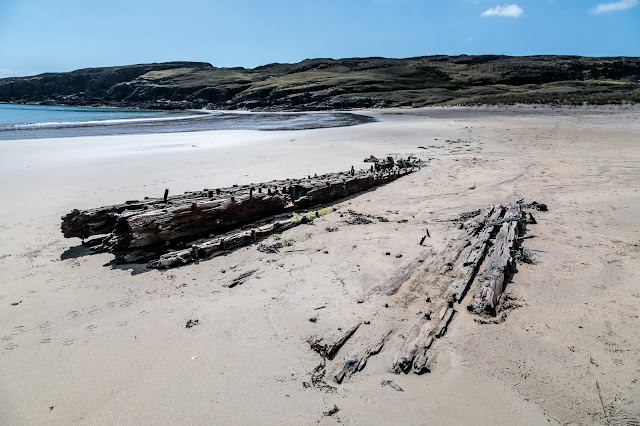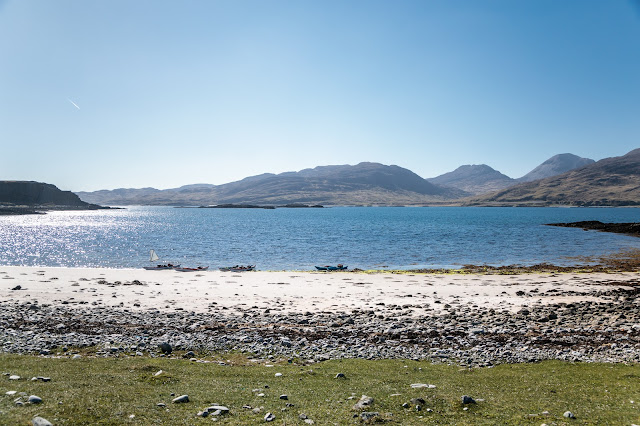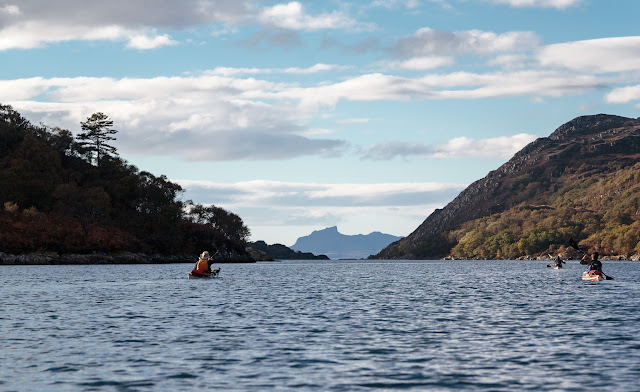We set off round the northern end of Colonsay and proceeded...
...down the remote and rocky east coast which is inhabited...
...only by a colony of feral goats. They are reputed to be decended from a flock which survived the wrecking of one of the great ships of the Spanish Armada in 1588.
With the hills of Islay in the distance, the ferry from Oban passed as our mini armada made its way to...
..the wonderful strand of Traigh Ban, or Balnahard Beach as the tourists call it.
Absolute consensus was reached, this was to be the location of...
...first luncheon, after which...
...we set off to explore this enormous beach...
...which is stunning, whichever way you look at it.
Right in the middle of the bay can be found...
....the sad remains of a wooden Swedish steamship, the SS Wasa. In 1920 she caught fire midway between the Dubh Artach rocks and the north end of Colonsay. 4 of the 28 crew were lost but 24 survivors were picked up by the trawler Hibernie II which towed the burning Wasa to this spot. If I were a Swedish sea kayaker I would not name my boat Wasa or Vasa!
All that remain are her keel timbers, still held together with rusting iron bolts. Clearly the SS Wasa has seen better days.
I climbed a steep dune at the back of the beach from which this magnificent panorama could be seen.
Slowly and almost reluctantly I made...
...my way back across the strand to where...
...the others were preparing to put to sea.
Read Ian's account here.
Imagine you are at the edge of the sea on a day when it is difficult to say where the land ends and the sea begins and where the sea ends and the sky begins. Sea kayaking lets you explore these and your own boundaries and broadens your horizons. Sea kayaking is the new mountaineering.
Showing posts with label natural history. Show all posts
Showing posts with label natural history. Show all posts
Saturday, January 06, 2018
Wednesday, January 03, 2018
Breaking the spell of the Cailleach Uragaig on the NW coast of Colonsay.
The only break in the rocky ramparts of the NW coast of Colonsay was at Port Ban but reefs at low tide prevent landing much of the time. Even if the swell allowed you land at HW, you would find yourself trapped by the surrounding cliffs. So we paddled on without a sideways glance.
Predominantly the species were razorbills and guillemots but there were also plenty of puffins. The air above us was full of whirring wings and...
...the sea was covered with rafts of resting birds. Fulmars and kittiwakes were also nesting at the edges of the main colonies and the mournful but atmospheric cries of the kittiwakes echoed round the geos.
The incessant noise of the birds and the smell of the white guano deposits which contrasted with the yellow lichen on the steeper parts of the cliffs left us in no doubt that we were in the environment of the birds. There was no sign of the hand of man, not even a lobster pot.
We were dwarfed by the scale of the place. It was very reminiscent of paddling round St Kilda. I have been on two boat supported paddling trips there and Ian has been on one. In many ways this was a more intense and close up experience as we had got here from the mainland (some 70km in our wakes) by ourselves.
We were well tired by the time we approached the bold headland of Cailleach Uragaig. Atop the headland rests the grim, grey visage of the Cailleach herself. The Cailleach Uragaig (The Hag of Colonsay) is a Celtic Goddess who has powers to shape shift herself so that she can appear as a hag, a mother or a virgin. She is a winter spirit who ushers in winter by washing her plaid in the Corryvreckan and she can often keep the arrival of spring at bay. On Colonsay she kept a young girl captive to steal her youth. She hid herself from the girl's angry lover by transforming herself into this rocky headland.
Tired sea kayakers always hope that the sands of Kiloran Bay will be just round the corner from the hag but they...
..are still 2km further on.
David was now getting very tired. It was 7pm and we had been paddling all day. David is well into his eighth decade and it is quite remarkable that he still has the stamina for such long trips. He thought I was being very gentlemanly waiting behind with him but in truth I was not well and having difficulty keeping up with him!
It really was a relief to paddle into Kiloran Bay where we intended to camp.
As soon as he got out of his kayaking gear David laid himself down on the machair and fell into such a deep sleep that we feared the Cailleach herself had enchanted him and that he might not awake for years! Fortunately we broke the Cailleach's spell, by opening a can of Guinness. The PSSSHT soon had David awake!
Read Ian's account here.
Monday, June 05, 2017
You may rue the day you meet the giant bothy rat and adders of Ruantallain.
On the second day of our trip to Orondsay and Colonsay we woke before dawn and were breakfasting by the time the sun rose above the hills of Jura.
It is always exciting setting off to a new island and neither Sam, Maurice nor...
...Ian had been before but David and I had circumnavigated Oransay and Colonsay from Islay and returned via Jura in September 2009.
We set off across the mouth of West Loch Tarbert leaving Glenbatrick and Lord Astor's summer house...
...far behind.
A fair wind soon carried us...
...across to Ruantallain.
Ruantallain was an ancient stopping off place on the voyage across to Oronsay. Our ancestors often had to leave the corpses of their dead here, if it was too rough to cross. The corpses were left in the Corpachs or "dead caves" at the foot of the raised sea cliffs behind the beach. Along the cliff faces, the dark entrances to the caves were like the empty eye sockets of the skulls within.
Not far from the shore lies the ruined farm stead of Ruantallain, which was finally abandoned in 1947. One half of the cottage with the tin roof is a locked estate refuge the other is an unlocked simple estate bothy. Tony and I had intended staying here here in June 2007 and David, Jennifer, Phil and I again considered it in September 2009. Our present little party had wondered why I did not consider staying here the previous evening. They were about to find out!
Tony and I were well tired when we arrived late in the day in 2007. The door creaked open and we let a little light into the gloom within. Two red eyes glared at us from the chair. It was a huge bothy rat. With great presence of mind Tony grabbed a log from a wood pile at the door and thew it at the rat. Any normal bothy rat would have bolted for its hole but this one charged at us. We fled to the shore. Where we pitched...
..our tents on the rather stony grass above the high tide mark.
It did not take long to discover that Ruantallain was a vipers's nest, literally hoaching with adders. Of course in the evening and morning these cold blooded creatures are less likely to slither away form your approach and are more likely to strike if you have not noticed them in time.
Now David knew all about the bothy rat and adders of Ruantallain, so like me he hung about the shore. The others thought I was prone to exaggeration and set off to the bothy discover for themselves... Well only Sam made it as far as the bothy. As soon as Ian and Maurice had left the beach they came across a coiled viper in the strike position. That was it, they went no further and reappeared on the beach with some undue haste. David and I nodded sagely at one another.
It was now time to set off from Jura across the sea to Oronsay and Colonsay. Fortunately our party had survived both rats and adders and so remained complete. We did not need to leave any dead in the Corpach of Ruantallain.
You can also follow this trip on Ian's blog here...
It is always exciting setting off to a new island and neither Sam, Maurice nor...
...Ian had been before but David and I had circumnavigated Oransay and Colonsay from Islay and returned via Jura in September 2009.
We set off across the mouth of West Loch Tarbert leaving Glenbatrick and Lord Astor's summer house...
...far behind.
A fair wind soon carried us...
...across to Ruantallain.
Ruantallain was an ancient stopping off place on the voyage across to Oronsay. Our ancestors often had to leave the corpses of their dead here, if it was too rough to cross. The corpses were left in the Corpachs or "dead caves" at the foot of the raised sea cliffs behind the beach. Along the cliff faces, the dark entrances to the caves were like the empty eye sockets of the skulls within.
Not far from the shore lies the ruined farm stead of Ruantallain, which was finally abandoned in 1947. One half of the cottage with the tin roof is a locked estate refuge the other is an unlocked simple estate bothy. Tony and I had intended staying here here in June 2007 and David, Jennifer, Phil and I again considered it in September 2009. Our present little party had wondered why I did not consider staying here the previous evening. They were about to find out!
Tony and I were well tired when we arrived late in the day in 2007. The door creaked open and we let a little light into the gloom within. Two red eyes glared at us from the chair. It was a huge bothy rat. With great presence of mind Tony grabbed a log from a wood pile at the door and thew it at the rat. Any normal bothy rat would have bolted for its hole but this one charged at us. We fled to the shore. Where we pitched...
..our tents on the rather stony grass above the high tide mark.
It did not take long to discover that Ruantallain was a vipers's nest, literally hoaching with adders. Of course in the evening and morning these cold blooded creatures are less likely to slither away form your approach and are more likely to strike if you have not noticed them in time.
Now David knew all about the bothy rat and adders of Ruantallain, so like me he hung about the shore. The others thought I was prone to exaggeration and set off to the bothy discover for themselves... Well only Sam made it as far as the bothy. As soon as Ian and Maurice had left the beach they came across a coiled viper in the strike position. That was it, they went no further and reappeared on the beach with some undue haste. David and I nodded sagely at one another.
It was now time to set off from Jura across the sea to Oronsay and Colonsay. Fortunately our party had survived both rats and adders and so remained complete. We did not need to leave any dead in the Corpach of Ruantallain.
You can also follow this trip on Ian's blog here...
Wednesday, February 22, 2017
More sea eagles than you can shake a stick at in Loch Moidart.
From the ancient walls of Tioram castle we...
...proceeded to explore the inner recesses of Loch Moidart with the flooding tide.
A series of delightful channels separate the many isles that dot the inner loch.
As we paddled deeper into the wilderness, clouds streamed out from the summits of the high hills creating delightful contrasts between light and shade.
Some of the isles plunge steeply into the sea but others are...
...easier to land on being low lying. However, beware of camping here if a high spring tide is due in the early morning. Attractive, close cropped, level grass becomes covered at HW.
It was a joy not to be racing to get through the tidal North Channel of Loch Moidart on a falling tide (as we have often done).
The line of the North Channel runs straight as a die and the iconic...
...summit of the Sgurr of Eigg draws the eye...
...towards the open sea. Suddenly Lorna saw yet another...
...sea eagle wheeling over the crags above the channel.
It is a bit of a sea eagle hot spot here. David and I had seen these two here seven months previously.
As we neared the sea the clouds drew back and we paddled the outer half of the North Channel in...
...glorious sunshine which enhanced the autumn colours.
At low tide the mouth of the North Channel is a maze of skerries but...
...at high tide most are covered. We exited the North Channel and entered the open sea with a most marvellous prospect over the Sea of the Hebrides to Eigg and Rum.
We now proceeded to Port Achad an Aonaich where we intended to...
...set up camp on the machair. I went for a quick swim in 11C water then...
...we set up the tents, but the day was not over yet..oh no!
For the full stereovision experience follow this trip on Ian's blog:
here and
here



























































